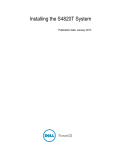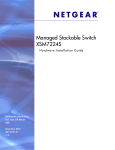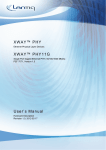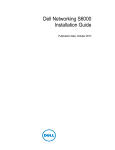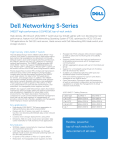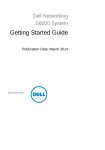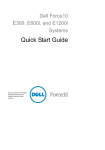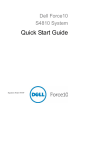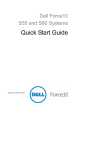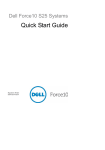Download Dell S4820T Specifications
Transcript
Dell Force10 S4820T System Getting Started Guide Publication Date: December 2012 Regulatory Model: S4820T Notes, Cautions, and Warnings NOTE: A NOTE indicates important information that helps you make better use of your computer. CAUTION: A CAUTION indicates potential damage to the hardware or loss of data if you do not follow the instructions. WARNING: A WARNING indicates a potential for property damage, personal injury, or death. If you purchased a Dell n Series computer, any references in this publication to Microsoft Windows operating systems are not applicable. ____________________ Information in this publication is subject to change without notice. © 2012 Dell Inc. All rights reserved. Reproduction of these materials in any manner whatsoever without the written permission of Dell Inc. is strictly forbidden. Trademarks used in this text: Dell™, the DELL logo, Dell Precision™, OptiPlex™, Latitude™, PowerEdge™, PowerVault™, PowerConnect™, OpenManage™, EqualLogic™, KACE™, FlexAddress™ and Vostro™ are trademarks of Dell Inc. Intel®, Pentium®, Xeon®, Core™ and Celeron® are registered trademarks of Intel Corporation in the U.S. and other countries. AMD® is a registered trademark and AMD Opteron™, AMD Phenom™, and AMD Sempron™ are trademarks of Advanced Micro Devices, Inc. Microsoft®, Windows®, Windows Server®, MS-DOS® and Windows Vista® are either trademarks or registered trademarks of Microsoft Corporation in the United States and/or other countries. Red Hat Enterprise Linux® and Enterprise Linux® are registered trademarks of Red Hat, Inc. in the United States and/or other countries. Novell® is a registered trademark and SUSE ™ is a trademark of Novell Inc. in the United States and other countries. Oracle® is a registered trademark of Oracle Corporation and/or its affiliates. Citrix®, Xen®, XenServer® and XenMotion® are either registered trademarks or trademarks of Citrix Systems, Inc. in the United States and/or other countries. VMware®, Virtual SMP®, vMotion®, vCenter®, and vSphere® are registered trademarks or trademarks of VMWare, Inc. in the United States or other countries. Other trademarks and trade names may be used in this publication to refer to either the entities claiming the marks and names or their products. Dell Inc. disclaims any proprietary interest in trademarks and trade names other than its own. Regulatory Model: S4820T 2012 - 12 P/N 0JF15T Rev. A00 Contents 1 About this Guide . . . . . . . . . . . . . . . . . . . . . . . . . 1 2 Introduction . . . . . . . . . . . . . . . . . . . . . . . . . . . . 3 Product Description . 3 Hardware Overview Fans . . . . . . . . . . . . . . . . . . . . . . . . . . . . . . . . . . . . . . . . . . . . . . . . . . . . . . . . . Front Panel . . . . . . . . . . . . . . . . . . . . . . . . . . . . . . . System Status 4 . . . . . . . . . . . . . . . . . . . . . . . . . . . . . . . . . . . . . . . . . . . . . . . . . . . . . . . . Installation . . . . . . . . . . . . . . . . . . . . . . . . . . . . . Unpacking the Switch 6 7 8 11 11 . . . . . . . . . . . . . . . . . . . . . . . . . . . . . . . . . . . . . . . . . . . . . . . . 11 11 . . . . . . . . . . . . . . . . . . . . . . . . . . . . 12 Install an AC or DC Power Supply Rack Mounting the Switch . . . . . . . . . . . . . . . . . . 13 . . . . . . . . . . . . . . . . . . . . . . 14 Rack Mounting Safety Considerations. Installing the Dell ReadyRails System . Installing the Switch . . . . . . . . . . 5 5 . . . . . . . . . . . . . . . . . . . . . . . . Package Contents Unpacking Steps . Power Supplies 3 . . . . . . . . . . . . . 14 15 19 . . . . . . . . . . . . . . . . . . 21 . . . . . . . . . . . . . . . . . . . . . . . 21 Technical Specifications . Chassis Physical Design . . . . . . . . . . . . . . . . . . . . . . . . . . . . . . . . . . . 21 . . . . . . . . . . . . . . . . . . . . . . . . . 22 Environmental Parameters Power Requirements . . . . . . . . . . . . . DC Input Specification . . . . . . . . . . . . . . . . . . . . . . Contents 22 1 Contents IEEE Standards . 6 . . . . . . . . . . . . . . . . . . . . . . . . . . . . Performing the Initial Configuration . . . . . . . . . . . 25 . . . . . . . . . . . . . . . . . . . . . . . . 25 . . . . . . . . . . . . . . . . . . . . . . . . . . . . 25 Navigating CLI Modes . Console Access Default Configuration . . . . . . . . . . . . . . . . . . . . . . . . . Configure Layer 2 (Data Link) Mode. Configure a Host Name 27 . . . . . . . . . . . . . . . . . . . . . . . . 27 . . . . . . . . . . . . . . . . . . . . . Configure the Management Port IP Address Configure the Management Route . . . . . . Configure the Username and Password . . . Create a Port-based VLAN. 28 . . . . . . . . . . 28 29 29 . . . . . . . . . . . . . . . . . . . 29 . . . . . . . . . . . . . . . . . . . . . . 30 Configure the Enable Password . Assign Interfaces to a VLAN . . . Assign an IP Address to a VLAN . . . . . . . . . . . . . . . . . . . . . . . . . . . . . . . . . . . . . . . . . . . . . . . . . . . . . Connecting the S4820T to the Network . Contents 27 . . . . . . . . . . . . . . . . . Access the System Remotely 2 23 . . . . . . . . . . . . . . . 30 32 32 Contents Contents 3 Contents 4 Contents About this Guide This document is intended as a Getting Started Guide to get new systems up and running and ready for configuration. For complete installation and configuration information, refer to the documents listed in Table 1-1. Table 1-1. S4820T Documents Information Documentation Hardware installation and power-up instructions Installing the S4820T System Software configuration FTOS Configuration Guide for the S4820T System Command line interface FTOS Command Line Reference Guide for the S4820T System Latest updates FTOS Release Notes for the S4820T System About this Guide 1 2 About this Guide 1 Introduction This document provides basic information about the S4820T switch, including how to install the switch and perform the initial configuration. For information about how to configure and monitor switch features, refer to the User’s Configuration Guide, which is available on the Dell Support website at support.dell.com/support. This document contains the following sections: • Hardware Overview • Installation • Technical Specifications • Performing the Initial Configuration Product Description S4820T is a top-of-rack (ToR) switch/router product for copper connections to 10G servers and 40Gbps uplinks to the 40G switching fabric in the core. The S4820T has 48 ports of 10GBase-T and four ports of 40Gbps with features and functions similar to the S4810 product. The S4820T switch runs the Dell Force10 Operating System (FTOS), providing switching, bridging, and routing functionality for transmitting data, storage, and server traffic. In a data center network, the S4820T switch provides converged network support and interoperates with Dell and third-party ToR devices. The switch supports data center bridging (DCB) features and optimizes connectivity between servers and storage devices using Fibre Channel over Ethernet (FCoE) and Internet Small Computer System Interface (iSCSI) links. By providing increased 40GbE bandwidth for device interconnection in a shared network storage environment, with the possibility of splitting 40GbE Quad Small Form-Factor Pluggable Plus (QSFP+) uplinks into 10GbE SFP+ connections, the S4820T switch is perfectly positioned to help transition a data center with multiple speed requirements. Introduction 3 The S4820T solution is optimized to provide 10Gbps throughput for distances of up to: 4 • 330 feet (100 meters) over Cat6, 6A, and 7 shielded copper cable and Cat6A UTP copper cable • 181.5 feet (55 meters) over Cat6 UTP copper cable Introduction Hardware Overview This section contains information about device characteristics and modular hardware configurations for the S4820T switch. The S4820T has the following physical dimensions: • 434 x 460 x 43.5 mm (W x D x H). • 17.09 x 18.11 x 1.71 inches (W x D x H). The S4820T has a chassis design with 640Gbps switching bandwidth as listed below: • S4820T = 48 port 10GBase-T + 4 port 40G QSFP+ The system also provides one RS-232 interface RJ-45 YOST console port and a dedicated Ethernet service port for out-of-band (OOB) management functions. The S4820T has the following features: • Supports one universal serial bus (USB) port • Forty-eight 10Gbps ports • Four fixed 40Gbps QSFP ports for a 40Gbps transceiver • On-board high-performance central processing unit (CPU) system with large memory, P2020/128 MB NOR Flash/2GB DDR III RAM. • Temperature monitoring (TMP75) • Software-readable thermal monitor • Real time clock (RTC) support • Hot-plugging redundant power supply • Current monitoring for Power management • Removable fan that you can manage • Standard 1U chassis high Hardware Overview 5 Fans The S4820T has stock keeping units (SKUs) that support the following configurations. Installation of the fans is done as part of the factory install based on SKU type. The power supply units (PSUs) are to be installed at the customer site (refer to Power Supplies). • AC PSU with fan airflow from I/O to PSU • AC PSU with fan airflow from PSU to I/O • DC PSU with fan airflow from I/O to PSU • DC PSU with fan airflow from PSU to I/O All fans and PSUs in a configuration must be in the same airflow direction. Should for some reason a mixed airflow configuration happen, the software is designed to notify you of the invalid configuration. Figure 1-1. S4820T Fan Modules Fan Module 0 Grab Handles 6 Hardware Overview Fan Module 1 Front Panel Figure 1-2 shows the S4820T front panel. Figure 1-2. S4820T Front Panel 10GBase-T Ports USB 2.0 Port QSFP+ Ports The front panel includes: • 48 fixed 10GBase-T and four fixed QSFP+ ports • One USB 2.0 port NOTE: The light emitting diodes (LEDs) display for System is on the front panel. The fan and power status indicators are on the back panel. Hardware Overview 7 System Status You can view S4820T status information in several ways, including LEDs and boot menu options. You can also view status information through the command line interface (CLI) show commands and with simple network management protocol (SNMP). For more information about these options, refer to the FTOS Command Line Reference Guide and FTOS Configuration Guide for the S4820T System. As shown in Figure 1-3, the S4820T includes LED displays on both the I/O and PSU side of the chassis. Figure 1-3. Port LEDs 1 System LED 3 2 5 4 6 7 6 7 1 - Locator LED (Blue) 2 - Stack LED (Blue/Green) 3 - Temp LED (Red) 4 - Diag LED (Green) 5 - FAN LED (Green/Red) 6 - Link LED (Green/Amber) 7 - Activity LED (Blinking Green) 8 Hardware Overview Table 1 lists the LED definitions for the S4820T system. Table 1. System LED Displays Feature System LED Detailed Description • Solid blue –Normal Operation Comment I/O side • Blinking blue –Booting • Solid red –Critical system error • Blinking red –Noncritical system error (fan fail, power supply fail) TEMP LED • Off: Normal temperature PSU side • Solid red –Overtemp (Refer NOTE:) DIAG LED • Off –Normal operating PSU side • Solid green –System Booting or Diagnostics FAN LED • Solid green –fan powered PSU side and running at the expected rpm • Solid red –fan failed STACK LED • Solid blue –Switch in stacking master mode PSU side • Solid green–Switch in stacking slave mode • Off – Switch in stand alone mode LOCATOR LED • Blinking blue – locator function is enabled PSU side • Solid blue – locator function is disabled NOTE: The system temperature threshold is 75°C. When one of the thermal sensors exceeds this temperature, the TEMP LED turns RED. Hardware Overview 9 Table 1-1. 10GBT Ethernet Port LEDs Feature Detailed Description Link LED • Off – No Link • Solid green –Link on 10Gbps speed • Solid Amber –Link on 100M or 1Gbps speeds Activity LED • Off – No Link • Blinking green – Transmit/Receive is active Table 1-2. QSFP+ Port LEDs Feature Detailed Description Link LED • Off – No Link • Solid green –Link on 40Gbps speed • Solid Amber –Link on other speeds Activity LED • Off – No Link • Blinking green – Transmit/Receive is active Table 1-3. OOB Ethernet Port LEDs Feature Detailed Description Link LED • Off – No Link • Solid green –Link on 1Gbps speed • Solid Amber –Link on 100M or 10M speeds Activity LED • Off – No Link • Blinking green – Transmit/Receive is active 10 Hardware Overview Installation Unpacking the Switch Package Contents When unpacking each switch, make sure that the following items are included: • One S4820T switch • One RJ-45 to DB-9 female cable • Two sets of rail kits (no tools required) • One PSU • One AC power cord (country/region specific) • Getting Started Guide • Safety and Regulatory Information • Warranty and Support Information • Software License Agreement Unpacking Steps NOTE: Before unpacking the switch, inspect the container and immediately report any evidence of damage. Step Task 1 Place the container on a clean, flat surface and cut all straps securing the container. 2 Open the container or remove the container top. 3 Carefully remove the switch from the container and place it on a secure and clean surface. 4 Remove all packing material. 5 Inspect the product and accessories for damage. Installation 11 Power Supplies The S4820T supports two hot-swappable power supplies units (PSUs) and fans that provide cooling for the system. The S4820T supports AC and DC power supplies with two air-flow directions (I/O to PSU and PSU to I/O). Two PSUs are required for full redundancy, but the system will operate with a single PSU. NOTE: If you use a single PSU, you must install a blank plate in the other PSU slot. Dell Force10 recommends using power supply 1 (PSU1) as the blank plate slot. The PSUs are field replaceable. When running with full redundancy (two power supplies installed and running), you can remove and replace one PSU while the other PSU is running without disrupting traffic. The S4820T does not support mixing PSU types. You cannot replace an AC PSU with a DC PSU and you cannot replace an AC-R PSU with a DC-R PSU. WARNING: Electrostatic discharge (ESD) damage can occur if components are mishandled. Always wear an ESD-preventive wrist or heel ground strap when handling the S4820T and its components. CAUTION: To prevent electrical shock, ensure the S4820T is grounded properly. If you do not ground your equipment correctly, excessive emissions may result. Use a qualified electrician to ensure the power cables meet your local electrical requirements. Figure 1-4. S4820T Power Supply PS0 12 Installation PS1 Install an AC or DC Power Supply To install an AC or DC power supply, follow these steps: NOTE: The PSU slides into the slot smoothly. Do not force a PSU into a slot as this may damage the PSU or the S4820T chassis. NOTE: Ensure that the PSU is correctly installed. When the PSU is correctly installed, the power connector is on the left side of the PSU and the status LED is at the top of the PSU NOTE: If you use a single PSU, you must install a blank plate in the other PSU slot. Dell Force10 recommends using power supply 1 (PSU1) as the blank plate slot. Step Task 1 Remove the PSU slot cover from the S4820T (PSU side of switch), either of the two PSU slots may be selected. 2 Remove the PSU from the electro-static bag. 3 • Insert the PSU into the switch PSU slot (PSU exposed PCB edge connector should be inserted first). • The PSU slot is keyed such that the PSU can only be fully inserted in one orientation. • When the PSU is installed correctly it should snap into place and be flush with the back of the switch. 4 Plug in the appropriate cord (AC 3 prong or DC wiring) from the switch PSU to the external power source (either AC wall outlet or DC rack bus bar). 5 If you have a redundant PSU (2nd PSU), repeat steps 1 through 5 above using the 2nd PSU slot on the S4820T switch. NOTE: The system powers up as soon as the cables are connected between the power supply and the power source. Installation 13 Rack Mounting the Switch You may either place the switch on the rack shelf or mount the switch directly into a 19" wide, EIA-310-E- compliant rack (four-post, two-post, or threaded methods). The Dell ReadyRails™ system is provided for 1U front-rack, and two-post installations. The ReadyRails system includes two separately packaged rail assemblies and two rails that are shipped attached to the sides of the switch. WARNING: This is a condensed reference. Read the safety instructions in your Safety, Environmental, and Regulatory information booklet before you begin. NOTE: The illustrations in this document are not intended to represent a specific switch. Rack Mounting Safety Considerations 14 • Rack loading—Overloading or uneven loading of racks may result in shelf or rack failure, causing damage to the equipment and possible personal injury. Stabilize racks in a permanent location before loading begins. Mount the components beginning at the bottom of the rack, then work to the top. Do not exceed your rack load rating. • Power considerations—Connect only to the power source specified on the unit. When multiple electrical components are installed in a rack, ensure that the total component power ratings do not exceed the circuit capabilities. Overloaded power sources and extension cords present fire and shock hazards. • Elevated ambient temperature—If installed in a closed rack assembly, the operating temperature of the rack environment may be greater than the room ambient temperature. Use care not to exceed the 40°C maximum ambient temperature of the switch. • Reduced air flow—Install the equipment in the rack so that the amount of airflow required for safe operation of the equipment is not compromised. • Reliable earthing—Maintain reliable earthing of rack-mounted equipment. Pay particular attention to the supply connections other than the direct connections to the branch circuit, for example: use of power strips. • Do not mount the equipment with the rear panel facing in the downward position. Installation Installing the Dell ReadyRails System The ReadyRails rack mounting system is provided to easily configure your rack for installation of your switch. The ReadyRails system can be installed using the 1U tool-less method or one of three possible 1U tooled methods (two-post flush mount, two-post center mount, or four-post threaded). 1U Tool-less Configuration (Four-post Square Hole or Unthreaded Round Hole): 1 With the ReadyRails flange ears facing outward, place one rail between the left and right vertical posts. Align and seat the rear flange rail pegs in the rear vertical post flange. In Figure 1-5, item 1 and its extractions show how the pegs appear in both the square and unthreaded round holes. Figure 1-5. 1U Tool-less Configuration 2 Align and seat the front flange pegs in the holes on the front side of the vertical post. Refer to Figure 1-5, item 2. 3 Repeat this procedure for the second rail. 4 To remove each rail, pull on the latch release button on each flange ear and unseat each rail. Refer to Figure 1-5, item 3. Installation 15 Two-post Flush-mount Configuration: 1 For this configuration, you must remove the castings from the front side of each ReadyRails assembly. Refer to Figure 1-6, item 1. Use a Torx driver to remove the two screws from each front flange ear (on the switch side of the rail) and remove each casting. Retain the castings for future rack requirements. It is not necessary to remove the rear flange castings. Figure 1-6. Two-post Flush-mount Configuration 2 Attach one rail to the front post flange with two user-supplied screws. Refer to Figure 1-6, item 2. 3 Slide the plunger bracket forward against the vertical post and secure the plunger bracket to the post flange with two user-supplied screws. Refer to Figure 1-6, item 3. 16 Installation 4 Repeat this procedure for the second rail. Two-post Center-mount Configuration: 1 Slide the plunger bracket rearward until it clicks into place and secure the bracket to the front post flange with two user-supplied screws. Refer to Figure 1-7, item 1. Figure 1-7. Two-post Center-mount Configuration 2 Slide the back bracket towards the post and secure it to the post flange with two user-supplied screws. Refer to Figure 1-7, item 2. 3 Repeat this procedure for the second rail. Installation 17 Four-post Threaded Configuration: 1 For this configuration, you must remove the flange ear castings from each end of the ReadyRails assemblies. Use a Torx driver to remove the two screws from each flange ear and remove each casting. Refer to Figure 1-8, item 1. Retain the castings for future rack requirements. 2 For each rail, attach the front and rear flanges to the post flanges with two user-supplied screws at each end. Refer to Figure 1-8, item 2. Figure 1-8. Four-post Threaded Configuration 18 Installation Installing the Switch You can mount the switch in the 1U front-rack or 1U two-post (flush and center) configurations. The following is an example of a 1U front-rack configuration. For the 1U two-post (flush and center) configurations, you can slide the switch into the rails in the same manner as the four-post configurations. 1U Front-rack Installation You must configure the rails that are attached to the switch. 1 Attach the switch rails (inner chassis members) to the S4820T switch. Figure 1-9, item 1 shows the detail for the front standoff with the locking tab. Figure 1-9. Attaching the Switch Rails Installation 19 2 After both switch rails are installed, line them up on the previously mounted Ready-Rails and slide the switch in until it is flush with front of rack. About three inches prior to full insertion, the rail locking feature engages to keep the switch from inadvertently sliding out of the rack and falling. 20 Installation Technical Specifications Operate the product at an ambient temperature not higher than 40°C. Lithium Battery Caution: There is a danger of explosion if the battery is incorrectly replaced. Replace only with same or equivalent type. Dispose of the batteries according to the manufacturer's instructions. Chassis Physical Design Parameter Specifications Height 1.71 inches (43.5 mm) Width 17.09 inches (434 mm) Depth 18.11 inches (460 mm) Environmental Parameters Parameter Specifications Operating temperature 32° to 104°F (0° to 40°C) Operating humidity 10 to 85% (RH), non-condensing Storage temperature –40° to 158°F (–40° to 70°C) Storage humidity 5 to 95% (RH), non-condensing Maximum thermal output 419.7 BTU/hr Technical Specifications 21 Power Requirements Parameter Specifications Power supply 100–240 VAC 50/60 Hz Maximum current draw per system 4 A @ 398.02watts/100vac 2 A @ 398.02watts/200vac Maximum power consumption 398.02 Watts Reliability MTBF 355,178 hours NOTE: The table below represents the DC PSU’s capabilities and does not represent the S4820T operation. DC Input Specification The power supply operates within all specified limits over the following input voltage range. min/max input voltage range −40.5V /−48V/ −60V input power at full load −40.5V/970W −48V/930W −60V/950W (without fan) −40.5V/980W −48V/940W −60V/960W (with fan) input current at full load −40.5V/23.8A −48V/19.0A −60V/15.6A (without fan) −40.5V/24A −48V/19.2A −60V/16.0A (with fan) Start up VDC 39.0+/−1.5V Start off VDC 37.5+/−1.5V 22 Technical Specifications IEEE Standards The S4820T switch complies with the following IEEE standards: •802.1AB LLDP •802.1ag Connectivity fault Management •802.1D Bridging, STP •802.1p L2 Prioritization •802.1Q VLAN Tagging, Double VLAN Tagging, GVRP •802.1s MSTP •802.1w RSTP •802.3ab Gigabit Ethernet (1000BASE-T) •802.3ac Frame Extensions for VLAN Tagging •802.3ad Link Aggregation with LACP •802.3ae 10 Gigabit Ethernet (10GBASE-X) •802.3ba 40 Gigabit Ethernet (40GBase-SR4, 40GBase-CR4) on optical ports •802.3u Fast Ethernet (100BASE-TX) •802.3x Flow Control •802.3z Gigabit Ethernet (1000BASE-X) Technical Specifications 23 24 Technical Specifications 2 Performing the Initial Configuration Navigating CLI Modes The FTOS prompt changes to indicate the CLI mode. You must move linearly through the command modes, with the exception of the end command which takes you directly to EXEC Privilege mode and the exit command which moves you up one command mode level. Console Access NOTE: Before starting this procedure, be sure you have a terminal emulation program already installed on your PC. The RS-232/RJ-45 console port is labeled on the upper right-hand side of the S4820T system as you face the Input/Output (I/O) side of the chassis (Figure 2-1). Figure 2-1. RS-232/RJ-45 Console Port RJ-45 Console Port Performing the Initial Configuration 25 To set up the RS-232/RJ-45 console port, follow these steps: Step Task 1 Install an RJ-45 copper cable into the console port. Use a rollover cable to connect the S4820T console port to a terminal server. 2 Connect the other end of the cable to the DTE terminal server. 3 Set the default terminal settings as follows: • 9600 baud rate • No parity • 8 data bits • 1 stop bit • No flow control Accessing the RJ-45 Console Port with a DB-9 Adapter If the DTE has a DB-9 interface, you can connect to the console using an RJ-45 to DB-9 adapter along with the RJ-45 rollover cable. Table 2-1 lists the pin assignments. Table 2-1. Pin Assignments Between the Console and a DTE Terminal Server Console Port RJ-45 to RJ-45 Rollover Cable RJ-45 to DB-9 Adapter Terminal Server Device Signal RJ-45 Pinout RJ-45 Pinout DB-9 Pin Signal RTS 1 8 8 CTS NC 2 7 6 DSR TxD 3 6 2 RxD GND 4 5 5 GND GND 5 4 5 GND RxD 6 3 3 TxD NC 7 2 4 DTR CTS 8 1 7 RTS 26 Performing the Initial Configuration Default Configuration A version of FTOS is pre-loaded onto the S4820T system; however, the system is not configured when you power up for the first time (except for the default host name, which is FTOS). You must configure the system using the CLI. Configure Layer 2 (Data Link) Mode Use the switchport command in INTERFACE mode to enable Layer 2 data transmissions through an individual interface. You cannot configure switching or Layer 2 protocols such as Spanning Tree Protocol (STP) on an interface unless the interface has been set to Layer 2 mode. To configure Layer 2 mode, follow these steps: Step Task Command Syntax Command Mode 1 Enable the interface. no shutdown INTERFACE 2 Place the interface in Layer 2 (switching) mode. switchport INTERFACE To view the interfaces in Layer 2 mode, use the show interfaces switchport command in EXEC mode. Configure a Host Name The host name appears in the prompt. The default host name is FTOS. Host names must start with a letter, end with a letter or digit, and must have characters, letters, digits, and hyphens in the string. To configure a host name, follow this step: Task Command Syntax Command Mode Create a new host name. hostname name CONFIGURATION Performing the Initial Configuration 27 Access the System Remotely You can configure the S4820T system to be accessed remotely by Telnet. The system has a dedicated management port and a management routing table that is separate from the IP routing table. To access the system remotely, follow these steps: Step Task 1 Configure an IP address for the management port (Configure the Management Port IP Address). 2 Configure a management route with a default gateway (Configure the Management Route). 3 Configure a username and password (Configure the Username and Password). Configure the Management Port IP Address In order to access the system remotely, assign IP addresses to the management ports. To assign IP addresses to the management ports, follow these steps: Step Task 28 Command Syntax Command Mode 1 Enter INTERFACE mode for the Management port. interface ManagementEthernet slot/port CONFIGURATION 2 Assign an IP address to the interface. ip address ip-address/mask INTERFACE 3 Enable the interface. no shutdown INTERFACE Performing the Initial Configuration Configure the Management Route Define a path from the S4820T to the network from which you are accessing the S4820T remotely. Management routes are separate from IP routes and are used to manage the S4820T through the management port. To configure a management route, follow this step: Task Command Syntax Configure a management route ip-address/mask management route to gateway the network from which you are accessing the system. Command Mode CONFIGURATION Configure the Username and Password To access the system remotely, configure a system username and password. To configure a username and password, follow this step: Task Command Syntax Configure a username username username [encryption-type] and password to password access the system remotely. Command Mode CONFIGURATION Configure the Enable Password Access EXEC Privilege mode using the enable command. EXEC Privilege mode is unrestricted by default. As a basic security measure, configure a password. There are two types of enable passwords: • enable password—stores the password in the running/startup configuration using a data encryption standard (DES)-encryption method. • enable secret—stores the running/startup configuration using a stronger, MD5-encryption method. Dell Force10 recommends using the enable secret password. Performing the Initial Configuration 29 To configure the enable secret password, follow this step: Task Command Syntax Command Mode Create a password to access EXEC Privilege mode. enable [password | secret] [level level] [encryption-type] password CONFIGURATION Create a Port-based VLAN The Default VLAN (VLAN 1) is part of the system startup configuration and does not require configuration. To configure a port-based VLAN, you must create the VLAN and then add physical interfaces or port channel (LAG) interfaces to the VLAN. To create a port-based VLAN, follow this step: Task Command Syntax Configure a port-based VLAN (if the interface vlan vlan-id vlan-id is different from the Default VLAN ID) and enter INTERFACE VLAN mode. After you create a VLAN, you must assign interfaces in Layer 2 mode to the VLAN to activate the VLAN. Command Mode CONFIGURATION To view the configured VLANs, use the show vlan command in EXEC Privilege mode. Assign Interfaces to a VLAN You can only assign interfaces in Layer 2 mode to a VLAN using the tagged and untagged commands. To place an interface in Layer 2 mode, use the switchport command. You can designate Layer 2 interfaces as tagged or untagged. When you place an interface in Layer 2 mode using the switchport command, the interface is automatically designated untagged and placed in the Default VLAN. 30 Performing the Initial Configuration To view which interfaces are tagged or untagged and to view which VLAN the interfaces belong, use the show vlan command. To view just the interfaces that are in Layer 2 mode, use the show interfaces switchport command in EXEC Privilege mode or EXEC mode. To tag frames leaving an interface in Layer 2 mode, you must assign that interface to a port-based VLAN to tag it with that VLAN ID. To tag interfaces, follow these steps: Step Task Command Syntax Command Mode 1 Access the interface vlan vlan-id INTERFACE VLAN mode of the VLAN to which you want to assign the interface. CONFIGURATION 2 Enable an interface to tagged interface include the IEEE 802.1Q tag header. INTERFACE Use the untagged command to move untagged interfaces from the Default VLAN to another VLAN: To move untagged interfaces, follow these steps: Step Task Command Syntax Command Mode 1 Access the interface vlan vlan-id INTERFACE VLAN mode of the VLAN to which you want to assign the interface. CONFIGURATION 2 Configure an interface untagged interface as untagged. This command is available only in VLAN interfaces. INTERFACE Performing the Initial Configuration 31 Assign an IP Address to a VLAN VLANs are a Layer 2 feature. For two physical interfaces on different VLANs to communicate, you must assign an IP address to the VLANs to route traffic between the two interfaces. The shutdown command in INTERFACE mode does not affect Layer 2 traffic on the interface. NOTE: You cannot assign an IP address to the Default VLAN, which, by default, is VLAN 1. To assign another VLAN ID to the Default VLAN, use the default vlan-id vlan-id command. To assign an IP address to a VLAN, follow this step: Task Command Syntax Configure an IP address ip address ip-address mask and mask on the interface. [secondary] Command Mode INTERFACE Connecting the S4820T to the Network After you have completed the hardware installation and software configuration for the S4820T system, you can connect to your company network by following your company’s cabling requirements. 32 Performing the Initial Configuration Printed in the U.S.A. w w w. d e l l . c om | s u p p o r t . d e l l . c om







































